70% of HR leaders in a new survey tell us they’ve received fewer complaints of toxic behavior since transitioning to hybrid or remote work.
This report is the second installment in a series on company culture in the new normal. In part one, we looked at the decline of work friendships.
On top of giving employees more flexibility and saving money on office space, companies that have made the transition to hybrid and remote work have discovered an additional benefit they probably didn’t expect: A reduction in toxic workplace behaviors like bullying, racism, and sexual harassment.
That’s according to Capterra’s 2022 Remote Work Culture Survey, in which a significant number of HR leaders at organizations who transitioned to hybrid or remote work tell us that they've received fewer complaints of toxic behavior after the shift, and felt their culture become less toxic overall. The number of HR leaders calling their culture “somewhat” or “extremely” toxic also dropped by nearly half after the shift (47%).
With toxic work culture being a primary driver of The Great Resignation, can something as simple as letting employees work from home more often actually reduce toxicity in your organization and help retain your best employees? As we’ll explain in this report, HR leaders need to pair their work arrangement with the right policies and tools to be effective. If they do so, a real reduction in toxic employee behavior isn’t just possible—it’s likely.
Key findings
HR reports of toxic behavior at work are down significantly after shift: 70% of HR leaders say they’ve received fewer complaints from employees about toxic behavior since their organization transitioned to hybrid/remote work.
Employees agree that work is less toxic now: 38% of employees who have transitioned to hybrid/remote work have noticed less toxic workplace behavior compared to before the transition. Only 13% have noticed more toxic behavior.
Bullying, racism, sexism, and gaslighting all see reductions: Across nine toxic behaviors, a majority of HR leaders and employees report seeing either less of the behavior than before they moved to hybrid/remote work or none at all.
Technology is helping reduce toxic workplace behaviors: A majority of HR leaders and employees at hybrid/remote businesses that use employee monitoring tools agree they are helping reduce toxic work behavior in their organization.
HR leaders say hybrid/remote work is reducing toxic employee behavior
Toxic culture is a pervasive and expensive problem for employers. In a 2019 study, SHRM found that one in five U.S. workers had left a job in the past five years because of a toxic work environment, bleeding those organizations of an estimated $223 billion in turnover costs. In addition to the cost of attrition, the employees that stick around in a toxic environment are notably less productive.
With toxic cultures now fueling the largest exodus of workers in modern history, employers are becoming desperate for answers, and a completely viable solution is potentially sitting right under their noses. Could letting employees work from home—something 82% of organizations already plan to allow long-term—actually make a company’s culture less toxic?
To find out, we surveyed close to 200 HR leaders at organizations where employees transitioned from working the entire time on-site (at an office, store, or other central location) to working some or all of the time remotely. Before the transition, nearly a third (32%) say their organization’s culture was “somewhat” or “extremely” toxic. After the transition, that number dropped to just 17%—an incredible 47% reduction.
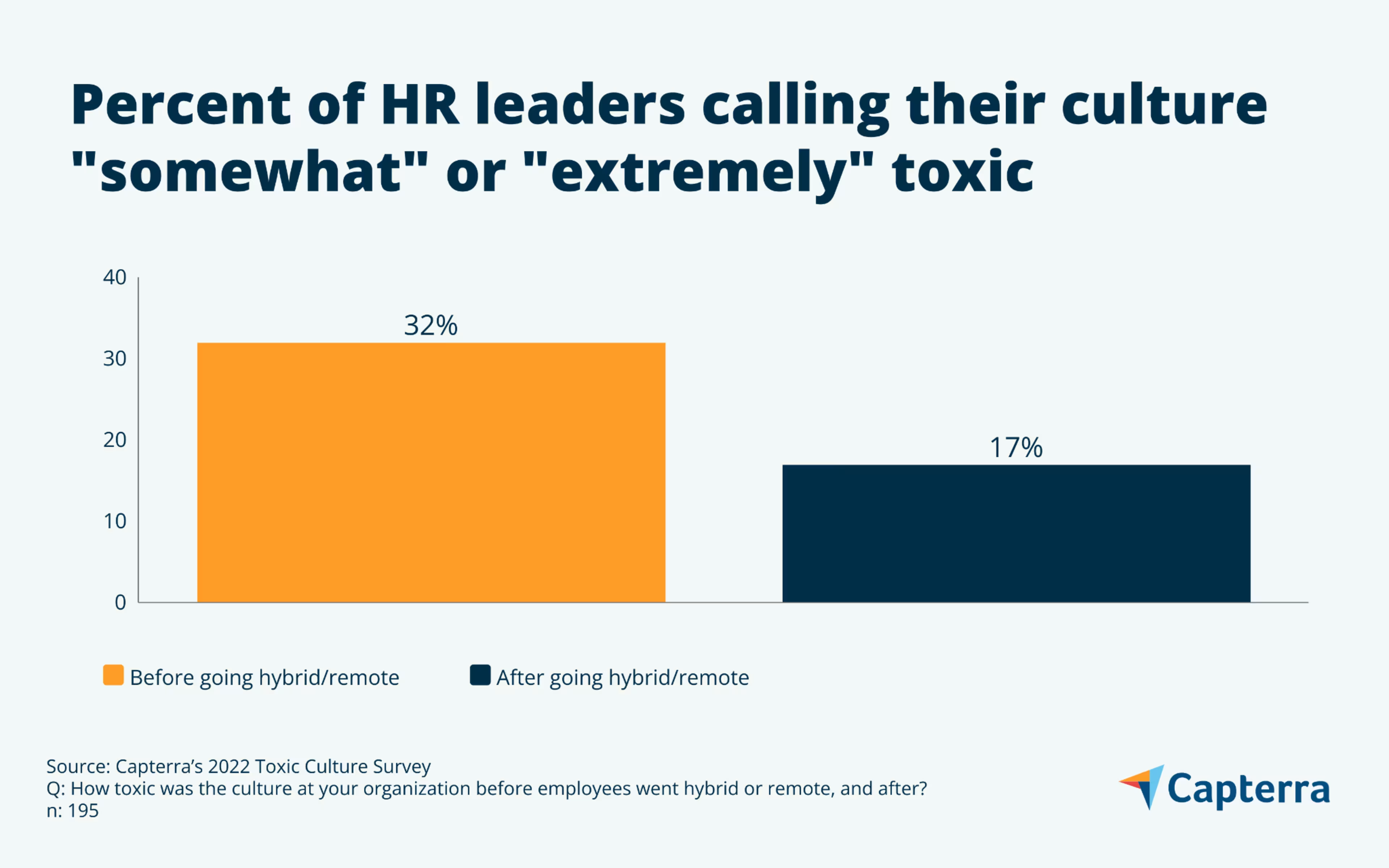
HR managers at remote businesses were more likely to say their culture was toxic before the shift than those at hybrid businesses (41% vs. 23%). However, both remote and hybrid businesses saw a similar reduction in the number of HR leaders calling their culture toxic after the shift (46% vs. 52%).
Not only are HR leaders feeling a difference in their culture since the shift to hybrid/remote work, they’re noticing it in their inbox, too. Since transitioning to hybrid/remote work, 70% of HR leaders say they’ve received fewer complaints from employees about toxic behavior.
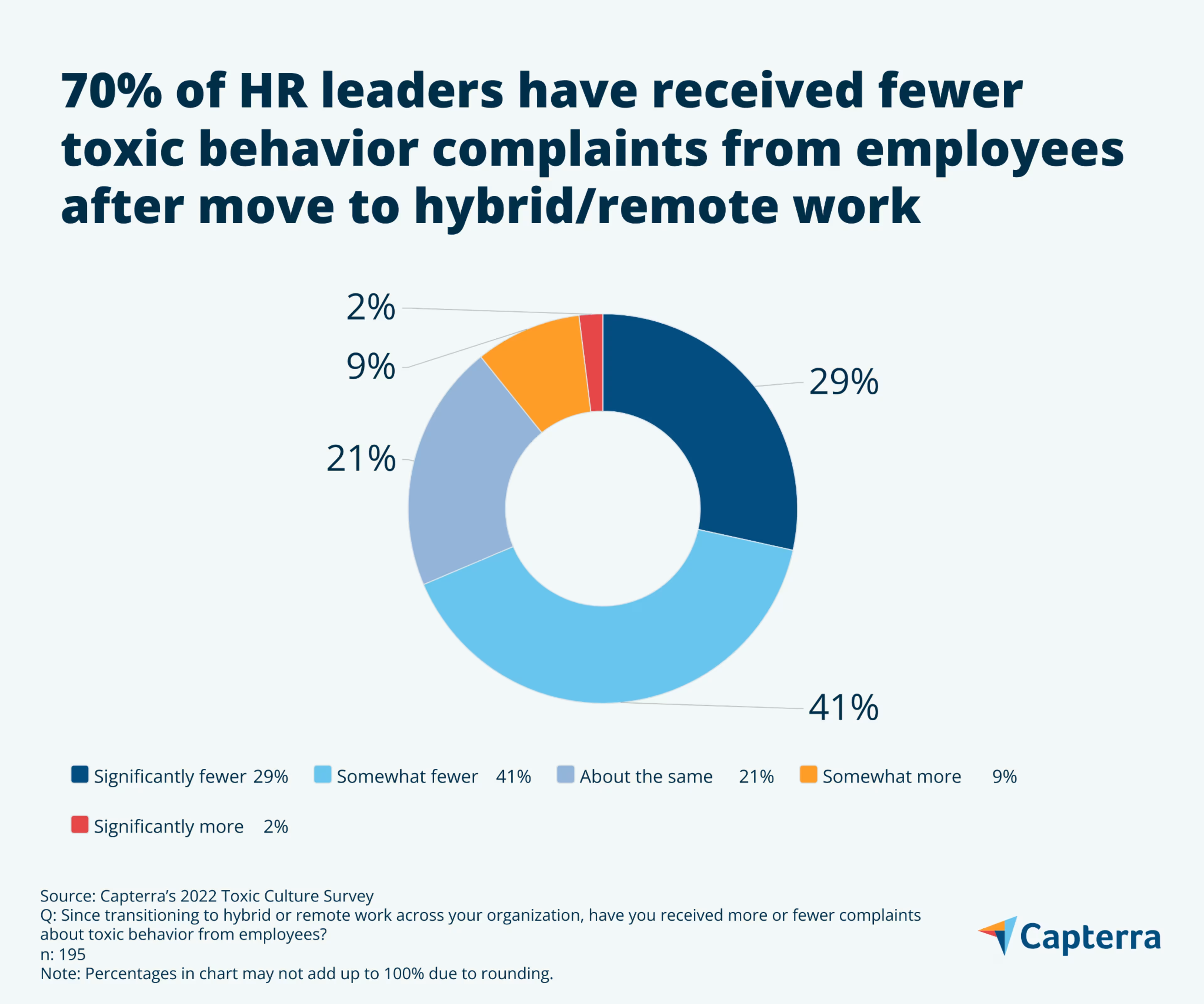
Again, we see that remote businesses benefited the most from the shift: 74% of HR leaders at remote businesses report getting fewer complaints, compared to 65% of hybrid businesses.
But the real winners of the move to hybrid/remote work have been small businesses. Compared to only 27% of HR leaders at midsize companies (101-500 employees) and 26% at enterprises (501+ employees), 46% of HR leaders at hybrid/remote small businesses (100 employees or less) say they have received significantly fewer complaints of toxic behavior after the transition.
Since going hybrid/remote, workers are also noticing less toxic behavior
Given that HR has a limited vantage point in the organization and toxic behavior can often go undetected if it’s not reported, we also surveyed over 500 employees who transitioned from working fully on-site to working remotely at least some of the time to gain their perspective.
While the results are less drastic than those of our HR leaders, our findings still suggest that the move to hybrid/remote work has been beneficial to reducing undesired behaviors. Overall, 38% of employees say they have noticed less toxic workplace behavior since moving to hybrid/remote work. Only 13% say they’ve noticed more toxic behavior, while nearly half (49%) say the amount of toxic behavior is about the same as before.
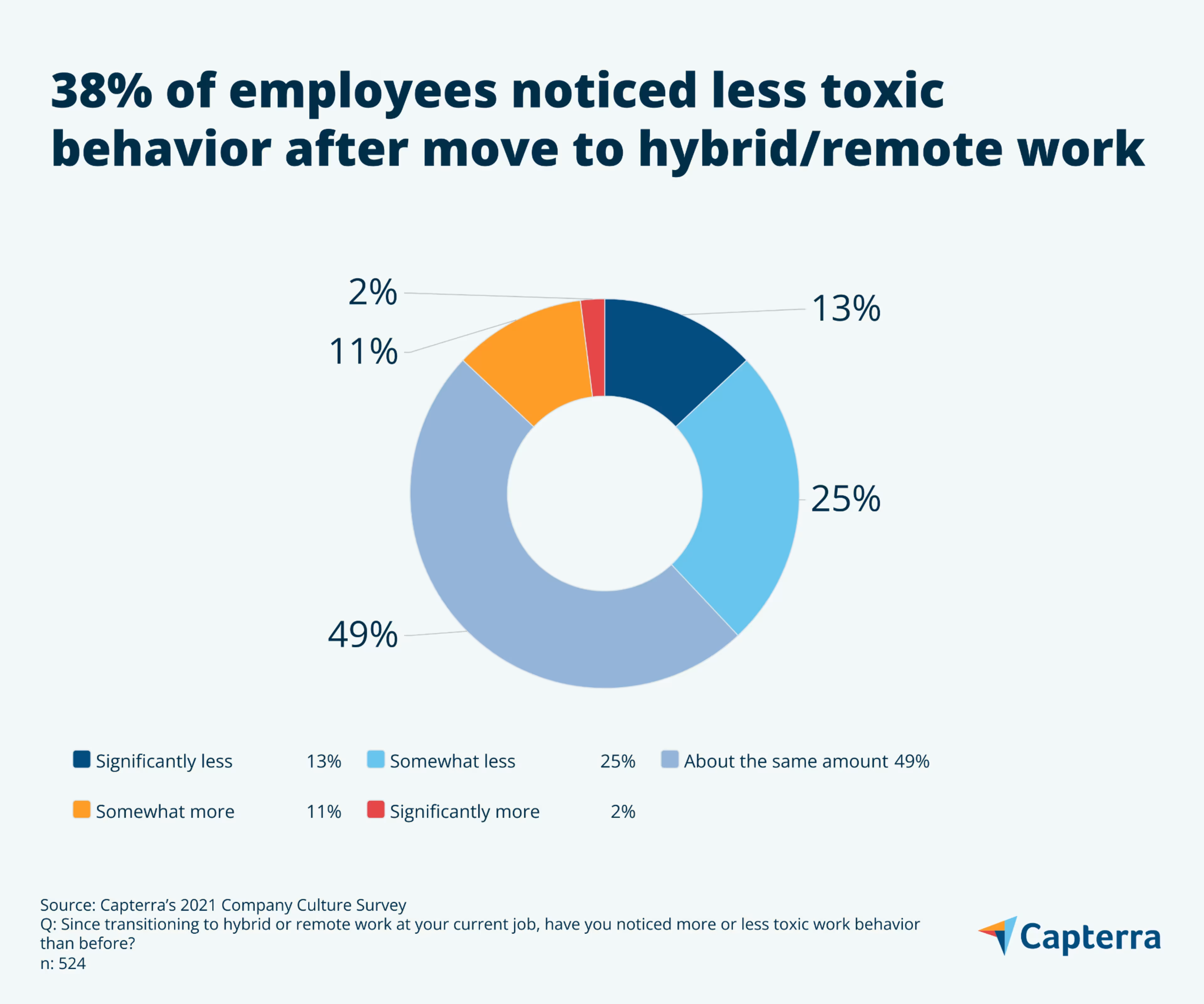
Breaking these results down further, we notice a few trends:
Similar to HR leaders, more remote employees noticed a reduction in toxic work behavior after transitioning than hybrid employees (47% vs. 31%).
In contrast to HR leaders, more employees at enterprise businesses (47%) noticed a reduction in toxic work behavior after transitioning to hybrid/remote work than midsize (36%) or small-business employees (29%).
In general, the older a worker was, the more likely they were to notice a reduction in toxic work behavior after transitioning to hybrid/remote work.
Women who have transitioned to remote/hybrid work were more than twice as likely to say they've noticed significantly less toxic work behavior than men (20% vs. 8%).
Bullying, sexual harassment see biggest drop from move to hybrid/remote work
To understand which aspects of toxic culture improved the most by the move to hybrid/remote work, we asked both HR leaders and employees about nine specific toxic behaviors, ranging from the insidious (e.g., gossiping) to the obvious (e.g., yelling or fighting).
Across all nine behaviors, a majority of both groups report seeing either less of the toxic behavior than before or none at all. Ranking the behaviors based on which saw the biggest drop after the move to hybrid/remote work, we found that two appear in the top three for both the HR leader and employee groups: bullying and sexual harassment.
Toxic behaviors with biggest drop from transition to hybrid/remote work
HR leaders | Employees |
1. Sexism/sexual harassment 87% report either fewer complaints of sexism/sexual harassment or none at all since the transition. | 1. Racism 69% report either less prevalent racism or none at all since the transition. |
2. Bullying 86% report either fewer complaints of bullying or none at all since the transition. | 2. Bullying 68% report either less prevalent bullying or none at all since the transition. |
3. Nepotism 86% report either fewer complaints of nepotism or none at all since the transition. | 3. Sexism/sexual harassment 67% report either less prevalent sexism/sexual harassment or none at all since the transition. |
Q: How has the amount of complaints about the following toxic work behaviors changed at your organization since employees transitioned to hybrid or remote work? (n=195) | Q: How has the prevalence of the following toxic behaviors changed at your current job since transitioning to hybrid or remote work? (n=524) |
Because sexism and racism—the behaviors with the biggest drop according to HR leaders and employees, respectively—often affect some workers more than others, we took a closer look at our results. The good news is that female employees were more likely to say sexual harassment became less prevalent after the transition to hybrid/remote work than male employees (73% vs. 64%). We also found that racial minority workers were just as likely to say racism became less prevalent as white/causcasian workers (66% vs. 68%).
Why is hybrid/remote work less toxic? It’s not just distance
Across the board, we find that shifting to hybrid/remote work reduces toxic employee behavior. The big question is, why? On the one hand, it’s undeniable that hybrid/remote work formats put more physical distance between employees, which can drastically reduce the number of physical altercations at work.
But most toxic behavior at work isn’t physical, and can happen just as often over digital channels (such as email or collaboration tools like Slack) as it does when interacting face-to-face. And it’s in these digital interactions that we believe two factors play a significant role in reducing toxic behavior in hybrid/remote work formats: the ease of reporting and more intensive behavior monitoring.
Reporting toxic behavior is less intimidating when working remotely
Simply put, employees working from home feel more comfortable reporting toxic behavior than those working in an office. Our data tells us as much: Twice as many remote/hybrid employees say the transition to remote/hybrid work has made them feel more comfortable reporting toxic work behaviors to HR versus less comfortable (26% vs. 13%), with 61% reporting the same amount of comfort before and after the transition.
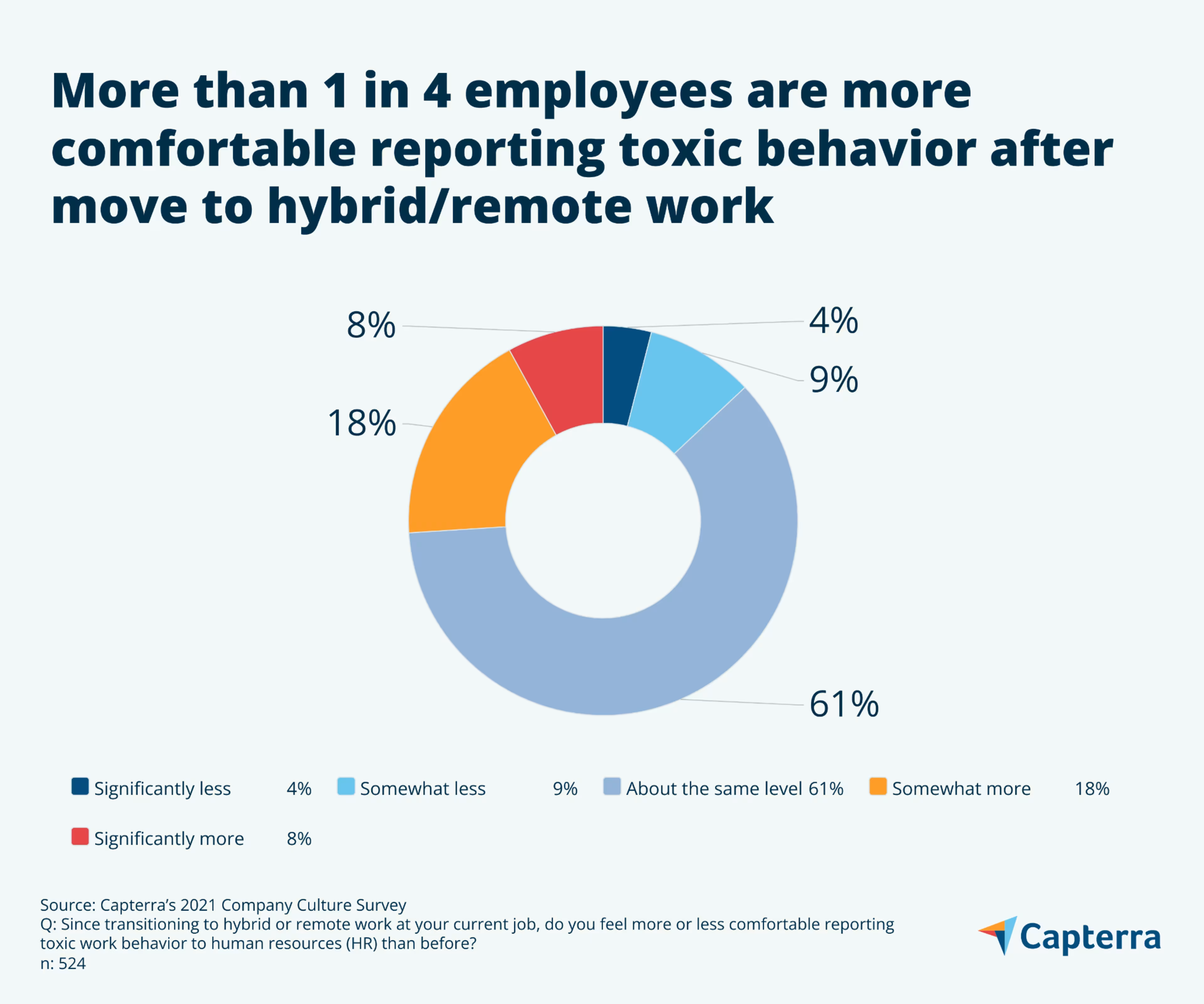
A fear of retaliation when reporting toxic behavior is warranted in many cases. The share of complaints for retaliation to the U.S. Equal Employment Opportunity Commission (EEOC) has grown from 36% of all charges in 2009 to 56% in 2020.
If a worker has to walk into an HR office where an abuser or other perpetrator might see them, they’ll be less likely to report toxic behavior. Working remotely, however, gives employees more discreet options for reporting misconduct, such as through email or an anonymous hotline form.
These methods aren’t perfect (a 2019 report found that only around a third of anonymous HR tips are substantiated) and your HR department needs to be diligent with following up and investigating allegations, but the more options that employees have for reporting misconduct, the better. That’s what hybrid/remote work provides.
Digital monitoring tools keep employees on their best behavior
In the first year of the COVID-19 pandemic, we learned that a majority of small businesses (53%) had invested in employee monitoring technology to keep a better eye on their employees. The goal was clear: Using keystroke loggers, screen capture devices, and other types of digital monitoring tools, managers and other business leaders wanted to ensure employees were staying productive outside of the office as they moved to hybrid/remote work formats.
But this mass adoption of monitoring tech has had the added benefit of reducing toxic behavior. Of the hybrid/remote HR leaders at organizations who use monitoring tools in our survey, 92% say the tools are helping reduce toxic work behavior in their organization. And 77% of monitored employees say the same thing.
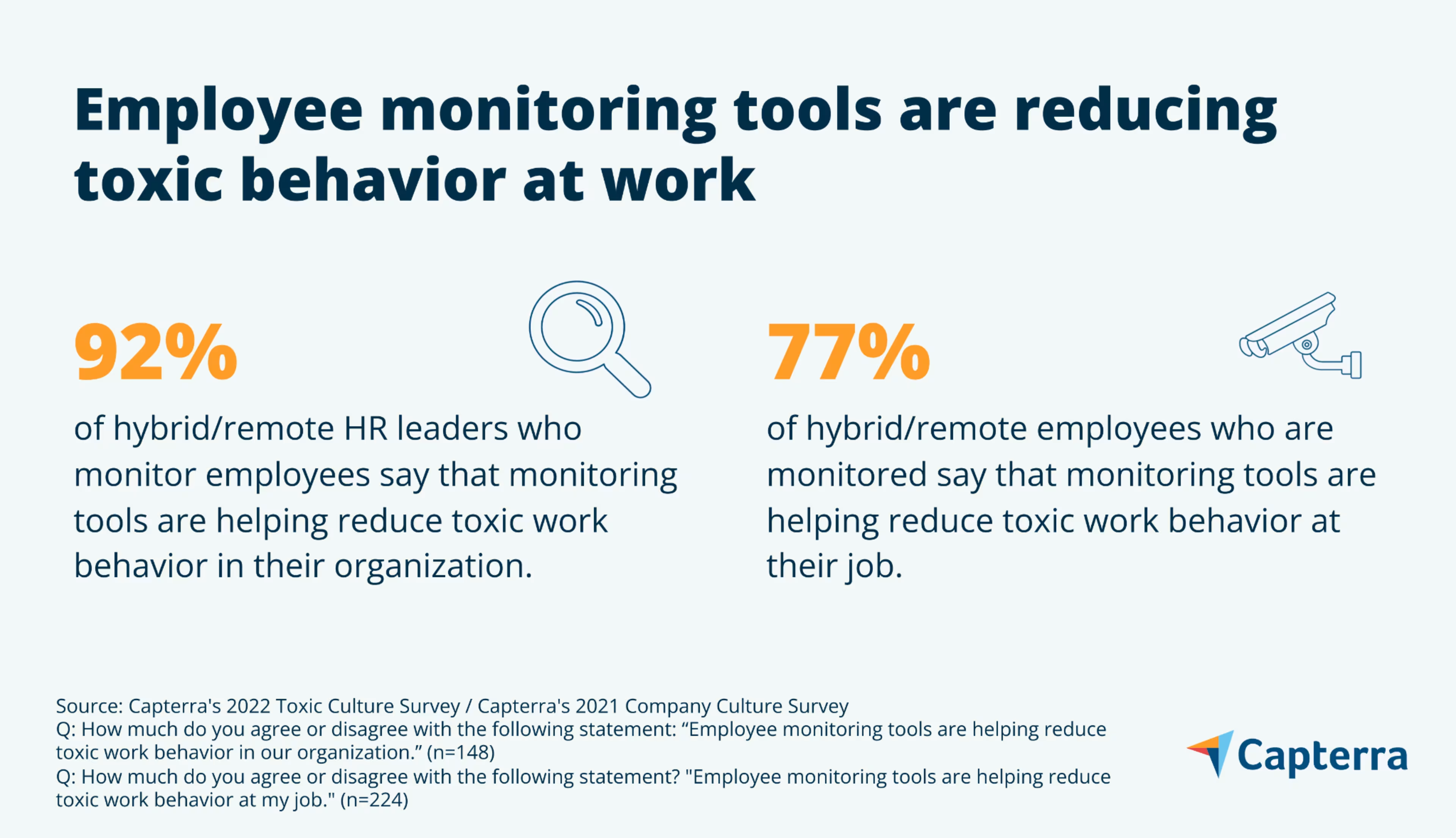
As opposed to in-person toxic behavior—which may not be recorded or seen by the right people—toxic behavior in digital spaces can more easily be proven by workers (who can save evidence to their computer) and substantiated by HR departments (who can go through archives and recordings in monitoring tools to witness the behavior in question).
Monitoring tools may not be boosting productivity as employers intended (53% of monitored small-business staff we surveyed say employee monitoring has no impact on how hard they work), but they are definitely encouraging workers to be on their best behavior.
If you’ve gone hybrid/remote already but don’t have any employee monitoring tools in place, consider getting some. Just be sure to communicate to your workforce that the tools are intended to discourage worker misconduct instead of weeding out low performers.
The bottom line for your business
Let’s go back to our original question: Can something as simple as letting employees work from home more often actually make your culture less toxic? The short answer is: not by itself.
A toxic culture can stem from a few bad apples or systemic rot that exists up and down the org chart. Going hybrid or remote will help with the former—reducing isolated incidents between co-workers—but it won’t do much for the latter, where toxic behavior is often celebrated or ignored.
Some aspects of toxic culture, like burnout, can be made worse in a hybrid or remote setup where the lines between work and life are blurred. Finally, as our survey shows, employees need multiple options to report toxic behavior, and trust that your organization will actually be monitoring digital spaces to ensure misbehavior is caught.
Here’s the good news though: Even on-site businesses that can’t go hybrid or remote at all can put these practices into place. Take toxic behavior seriously, give employees multiple avenues to report toxic co-workers, and start monitoring for abuse and bullying instead of productivity, and any business will start seeing positive results.
If you liked this report, check out these additional resources:
